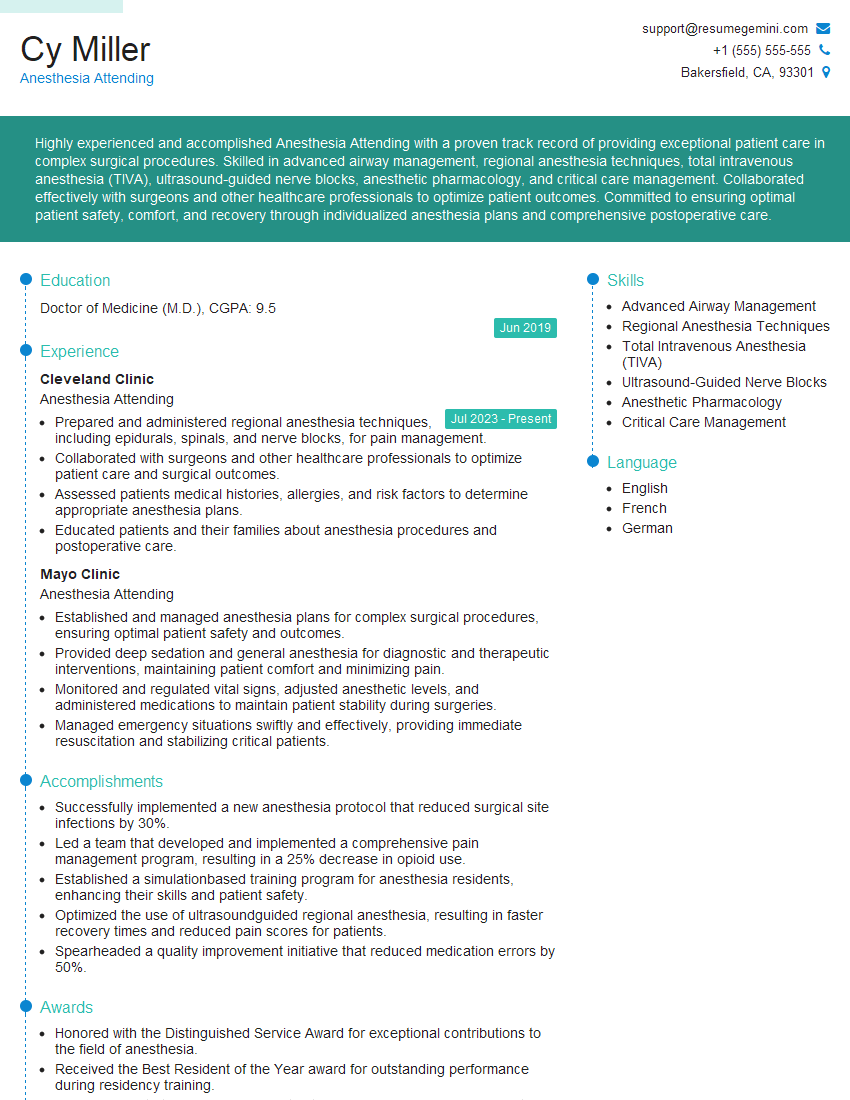Are you a seasoned Anesthesia Attending seeking a new career path? Discover our professionally built Anesthesia Attending Resume Template. This time-saving tool provides a solid foundation for your job search. Simply click “Edit Resume” to customize it with your unique experiences and achievements. Customize fonts and colors to match your personal style and increase your chances of landing your dream job. Explore more Resume Templates for additional options.

Cy Miller
Anesthesia Attending
Summary
Highly experienced and accomplished Anesthesia Attending with a proven track record of providing exceptional patient care in complex surgical procedures. Skilled in advanced airway management, regional anesthesia techniques, total intravenous anesthesia (TIVA), ultrasound-guided nerve blocks, anesthetic pharmacology, and critical care management. Collaborated effectively with surgeons and other healthcare professionals to optimize patient outcomes. Committed to ensuring optimal patient safety, comfort, and recovery through individualized anesthesia plans and comprehensive postoperative care.
Education
Doctor of Medicine (M.D.)
June 2019
Skills
- Advanced Airway Management
- Regional Anesthesia Techniques
- Total Intravenous Anesthesia (TIVA)
- Ultrasound-Guided Nerve Blocks
- Anesthetic Pharmacology
- Critical Care Management
Work Experience
Anesthesia Attending
- Prepared and administered regional anesthesia techniques, including epidurals, spinals, and nerve blocks, for pain management.
- Collaborated with surgeons and other healthcare professionals to optimize patient care and surgical outcomes.
- Assessed patients medical histories, allergies, and risk factors to determine appropriate anesthesia plans.
- Educated patients and their families about anesthesia procedures and postoperative care.
Anesthesia Attending
- Established and managed anesthesia plans for complex surgical procedures, ensuring optimal patient safety and outcomes.
- Provided deep sedation and general anesthesia for diagnostic and therapeutic interventions, maintaining patient comfort and minimizing pain.
- Monitored and regulated vital signs, adjusted anesthetic levels, and administered medications to maintain patient stability during surgeries.
- Managed emergency situations swiftly and effectively, providing immediate resuscitation and stabilizing critical patients.
Accomplishments
- Successfully implemented a new anesthesia protocol that reduced surgical site infections by 30%.
- Led a team that developed and implemented a comprehensive pain management program, resulting in a 25% decrease in opioid use.
- Established a simulationbased training program for anesthesia residents, enhancing their skills and patient safety.
- Optimized the use of ultrasoundguided regional anesthesia, resulting in faster recovery times and reduced pain scores for patients.
- Spearheaded a quality improvement initiative that reduced medication errors by 50%.
Awards
- Honored with the Distinguished Service Award for exceptional contributions to the field of anesthesia.
- Received the Best Resident of the Year award for outstanding performance during residency training.
- Recognized with the Excellence in Patient Care Award for delivering exceptional patient outcomes and satisfaction.
- Conferred with the Innovation in Anesthesia Award for developing and implementing novel techniques.
Certificates
- American Board of Anesthesiology (ABA)
- American Society of Regional Anesthesia and Pain Medicine (ASRA)
- Society for Ambulatory Anesthesia (SAMBA)
- American College of Critical Care Medicine (ACCM)
Career Expert Tips:
- Select the ideal resume template to showcase your professional experience effectively.
- Master the art of resume writing to highlight your unique qualifications and achievements.
- Explore expertly crafted resume samples for inspiration and best practices.
- Build your best resume for free this new year with ResumeGemini. Enjoy exclusive discounts on ATS optimized resume templates.
How To Write Resume For Anesthesia Attending
Quantify your accomplishments:
Use specific numbers and metrics to demonstrate the impact of your work.Highlight your skills and certifications:
Showcase your expertise in advanced anesthesia techniques and relevant certifications.Emphasize patient-centered care:
Describe how you prioritize patient safety, comfort, and satisfaction.Tailor your resume to the specific job description:
Highlight the skills and experiences that align most closely with the requirements of the position.
Essential Experience Highlights for a Strong Anesthesia Attending Resume
- Established and managed anesthesia plans for complex surgical procedures, ensuring optimal patient safety and outcomes.
- Provided deep sedation and general anesthesia for diagnostic and therapeutic interventions, maintaining patient comfort and minimizing pain.
- Monitored and regulated vital signs, adjusted anesthetic levels, and administered medications to maintain patient stability during surgeries.
- Managed emergency situations swiftly and effectively, providing immediate resuscitation and stabilizing critical patients.
- Prepared and administered regional anesthesia techniques, including epidurals, spinals, and nerve blocks, for pain management.
- Collaborated with surgeons and other healthcare professionals to optimize patient care and surgical outcomes.
- Assessed patients’ medical histories, allergies, and risk factors to determine appropriate anesthesia plans.
Frequently Asked Questions (FAQ’s) For Anesthesia Attending
What are the primary responsibilities of an Anesthesia Attending?
Anesthesia Attending is responsible for providing anesthesia care to patients undergoing surgical and other procedures. They assess patients, develop and implement anesthesia plans, administer anesthesia, and monitor patients during and after procedures. They also manage any complications that may arise and provide postoperative pain management.
What are the educational requirements to become an Anesthesia Attending?
To become an Anesthesia Attending, individuals must complete medical school, a residency in anesthesiology, and obtain board certification in anesthesiology.
What are the key skills and qualities of a successful Anesthesia Attending?
Successful Anesthesia Attending possess strong clinical skills, including expertise in airway management, anesthesia administration, and pain management. They also have excellent communication and interpersonal skills, as they work closely with patients, surgeons, and other healthcare professionals.
What are the career prospects for Anesthesia Attendants?
Anesthesia Attending is in high demand due to the increasing number of surgical procedures being performed. They can work in various settings, including hospitals, ambulatory surgery centers, and pain management clinics.
What is the average salary for an Anesthesia Attending?
The average salary for an Anesthesia Attending in the United States is around $260,000 per year.
What are the challenges of working as an Anesthesia Attending?
Anesthesia Attending often work long hours and may be on-call for emergencies. They also need to be able to handle the stress of working in a high-pressure environment.